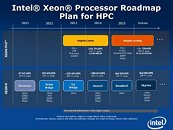Wednesday, July 3rd 2013

Intel 14-nanometer Skylake Platform To Support DDR4, PCIe 4.0, SATA Express
Intel's first chips based on the company's new, and Industry first, 14-nanometer manufacturing process are expected to hit markets in late 2015. With Skylake, Intel will introduce their new 9th-generation Intel HD IGP. The new platform will be the first to bring dual-channel DDR4 memory support. Skylake won't be the first platform to support DDR4 memory. In the 2H of 2014, Intel will launch their enthusiast grade Haswell-E platform, with support for quad-channel DDR4 memory. Skylake will be more of an evolution of Broadwell, which in turn is essentially an die shrink of Haswell to 14nm.
Additionally, the new mainstream platform will bring in support for PCI-E 4.0, essentially doubling the bandwidth offered by the current PCI-E 3.0 standard. More powerful GPUs from NVIDIA and AMD should be able to take advantage of the improved bandwidth, as their cards keep getting more and more powerful with each passing generation. Skylake will also introduce support for SATA Express. The advantage? SATA Express allows for a max bandwidth of about 16 Gb/s, more than 2.5x the 6 Gb/s bandwidth offered by the current SATA standard. While the product slide doesn't specify exactly as to when the first Skylake based products are scheduled to hit the market, our best guess places it at the end of 2015.
Source:
PC Games Hardware
Additionally, the new mainstream platform will bring in support for PCI-E 4.0, essentially doubling the bandwidth offered by the current PCI-E 3.0 standard. More powerful GPUs from NVIDIA and AMD should be able to take advantage of the improved bandwidth, as their cards keep getting more and more powerful with each passing generation. Skylake will also introduce support for SATA Express. The advantage? SATA Express allows for a max bandwidth of about 16 Gb/s, more than 2.5x the 6 Gb/s bandwidth offered by the current SATA standard. While the product slide doesn't specify exactly as to when the first Skylake based products are scheduled to hit the market, our best guess places it at the end of 2015.

36 Comments on Intel 14-nanometer Skylake Platform To Support DDR4, PCIe 4.0, SATA Express
The X79 quad + X79 motherboard combo doesn't cost that much more than a Z87 quad + Z87 mobo.
Sucks though that X79 is an oldtimer compared to Z87.
ODT
On Die Termination.
For memory operating at a significantly higher voltage than die traces can handle, meaning we either have to perform extra steps during manufacturing, or create more traces to dump the voltage.
For PCIe, most of the same reasons listed above.
For all other interconnects, see above.
When all Intel or AMD had to do was create a chip and the NB handled the voltage power differences, termination, and much else it wasn't an issue. However now that it is on die it is becoming much more difficult to maintain signal integrity at lower voltages while assuring reliability with multiple manufacturers of memory, motherboards, PCIe devices.
Add to this idea that if AMD has figured out heterogeneous memory, Intel is surely on the same path and as we approach the efficiency limit in processing serial data and find parallel falling behind without a "co-processor" added on that needs higher speed memory access we find the need to make the next jump in performance to occur.
In short, the people you are calling people sheeple in a vain attempt to cover your lack of knowledge know what and why this is needed, so not only do you look like a dick, but a stupid dick.